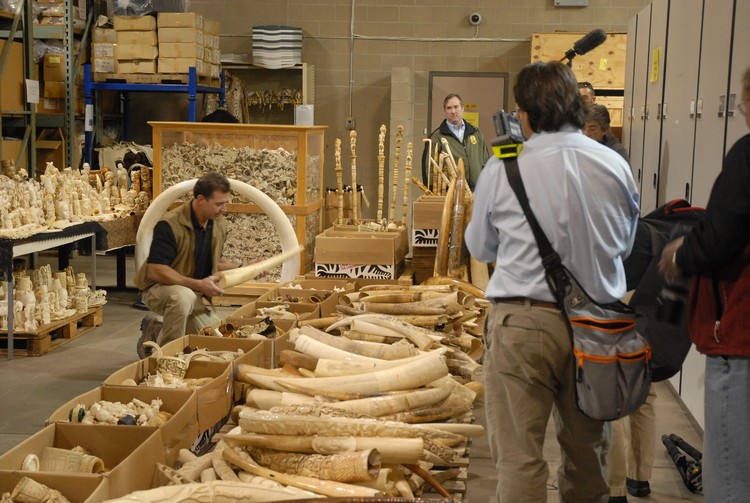Using carbon dating to stop elephant and rhino poaching
But even a controlled ivory trade may send the wrong message
Ivory seized in the United States. Photo Credit: Gavin Shire / US Fish and Wildlife Service on Flickr (CC BY 2.0)
For years, conservationists have struggled to find effective ways to combat the illegal trade in ivory. While it may sound like a tool only used by archaeologists to study ancient artefacts, carbon dating could soon become a powerful ally to protect Africa’s rhinos and elephants. Experts can now accurately determine the age of ivory and the age of the animal it came from.
The technique measures the levels of carbon-14, a naturally occurring radioactive element, in organic materials. After an animal dies, the carbon-14 in its ivory starts to decay at a predictable rate. By measuring the remaining carbon-14, scientists can pinpoint how long ago the animal died and exactly how old it was when it died.
If conservationists can determine that ivory being sold is from an animal that has died more than ten years prior to the sale, and that the animal had lived past its social and breeding years, then the sale of that ivory can be facilitated sustainably and legally.
This would undermine the black market trade of illegally poached ivory, as buyers would have a legal, sustainable avenue for ivory trade, as well as allowing populations of our precious animals to grow in a sustainable manner.
This is what some physicists and conservationists are now advocating: new laws that would permit the sale of older, naturally-sourced ivory.
It’s a solution that blends science with practical conservation efforts, offering a clear-cut way to differentiate between legal and illegal ivory. This transparency could bolster international efforts to crack down on poaching and ivory trafficking, as authorities could quickly and reliably test ivory to verify its age and origin.
Not so simple
But critics argue that legalising the ivory trade, even with strict regulations and carbon dating, could create loopholes that are too easily exploited, such as the forgery of certificates, making it even more difficult to trace and control trade than it already is. This could lead to an increase in poaching, as corrupt traders find ways to bypass the system.
There’s also the fear that a legal market might reignite demand for ivory, making it a desirable status symbol once more. This surge in demand could outpace the supply of naturally-sourced, sustainable ivory, putting even more pressure on elephant and rhino populations. Opening the doors to any form of ivory trade might send the wrong message: that it’s acceptable to profit from these awe-inspiring creatures, alive or dead.
While there are still discussions to be had and frameworks to develop, the potential of carbon dating in combating illegal ivory trade is exciting. It represents a fusion of science, conservation, and ethical trade practices. Carbon dating might not just about measuring the past; it might help create a better future for our animals, ensuring that they can continue to roam the wild for generations to come.
Support independent journalism
Donate using Payfast

Don't miss out on the latest news
We respect your privacy, and promise we won't spam you.
Next: Visually impaired recyclers help the planet
Previous: State of police college shocks Parliamentary committee
© 2024 GroundUp. This article is licensed under a Creative Commons Attribution-NoDerivatives 4.0 International License.
You may republish this article, so long as you credit the authors and GroundUp, and do not change the text. Please include a link back to the original article.
We put an invisible pixel in the article so that we can count traffic to republishers. All analytics tools are solely on our servers. We do not give our logs to any third party. Logs are deleted after two weeks. We do not use any IP address identifying information except to count regional traffic. We are solely interested in counting hits, not tracking users. If you republish, please do not delete the invisible pixel.

